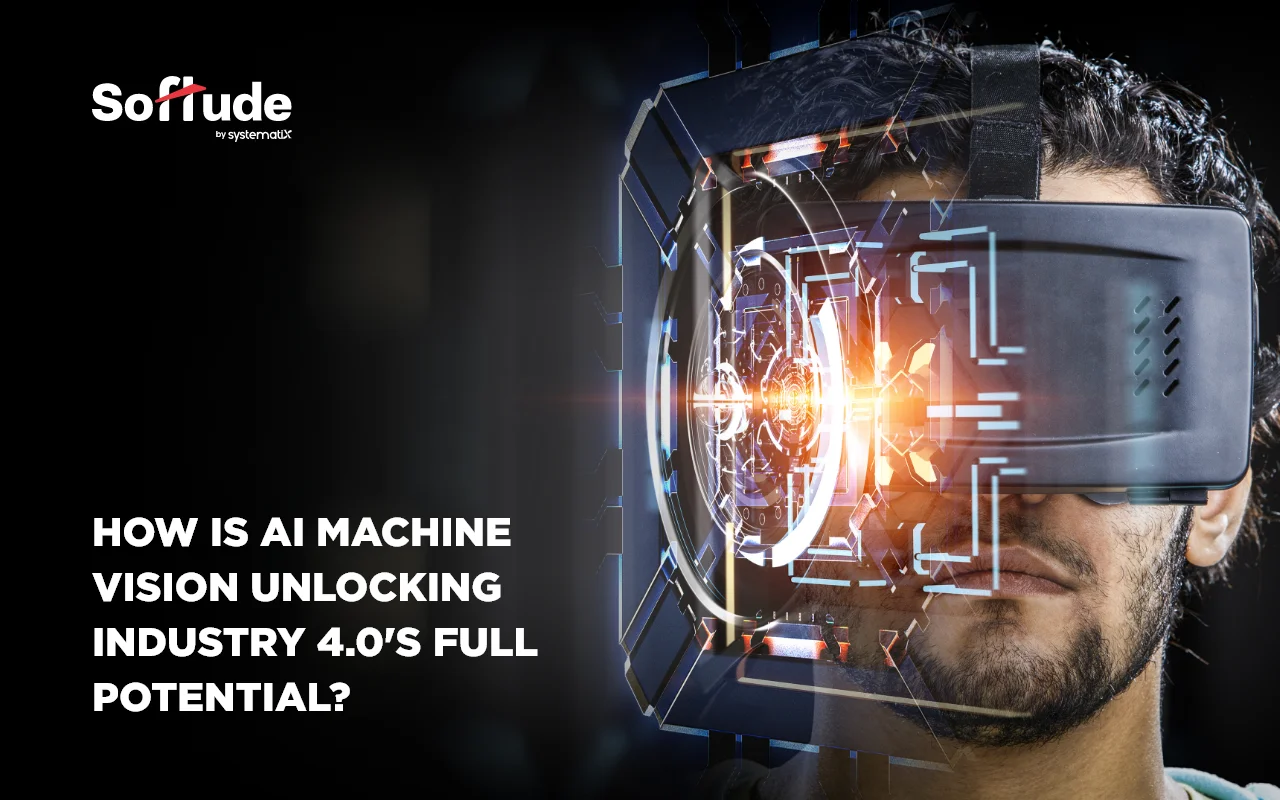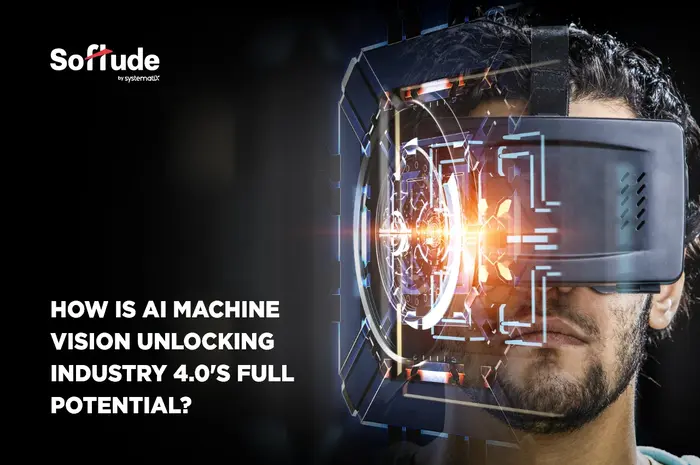
Machines got vision even before AI came into play. Those classic machine vision systems could do various tasks like identifying positing of objects, detecting defects by identifying color differences in objects, identifying shapes with an exact pattern, and much more. But things like detecting a minute defect in the product or an incorrect product label on the wrinkled package were out of the capabilities of the machine.
Artificial Intelligence rapidly expanded the capabilities of machines giving them SMART EYES. This growing technology is now transforming the way industries are operating. We will learn here, how exactly AI machine vision is transforming industry 4.0.
First Understand, What is AI Machine Vision?
It refers to the use of artificial intelligence and deep learning algorithms to enable computers to interpret and understand visual information. This type of machine vision goes beyond simple image analysis and instead uses complex algorithms to analyze images and extract meaningful information. Artificial intelligence and machine vision can be used to perform a wide range of tasks, including object recognition, facial recognition, image classification, and even image generation.
Here, deep neural networks are trained on large datasets of images to identify patterns and features in the data. These patterns are then used to make predictions about new images, allowing the system to recognize objects, classify images, and even generate new images.
5 Ways Industry 4.0 is Benefiting From AI-Based Machine Vision
AI vision has numerous exciting benefits, including:
1. Increased Efficiency and Accuracy: Machine vision systems powered by AI algorithms can perform tasks with high precision and accuracy, leading to increased efficiency in the manufacturing process. They can inspect and analyze large amounts of data in real time, reducing human error and the time required for manual inspection.
2. Improved Quality Control: These systems can detect and identify defects in real time, reducing the risk of faulty products being shipped. This results in a significant improvement in product quality and customer satisfaction.
3. Higher Production Rate: With AI machine vision systems in place, manufacturers can automate many processes that were previously done manually. This includes tasks such as quality control, inspection, and even assembly. By automating these processes, manufacturers can significantly increase their production rates. AI machine vision can perform these tasks faster and more accurately than humans, leading to more products being produced in a shorter amount of time. This increased speed also means that manufacturers can respond more quickly to changes in demand, enabling them to be more agile and responsive to market conditions.
4. Early Failure Prediction: Malfunctions in machinery and equipment can be detected even before they fail permanently with the help of machine vision systems. This reduces downtime and maintenance costs and increases overall equipment efficiency.
5. Real-time Monitoring: The manufacturing process requires monitoring in real-time to be saved from the major consequences. With machines having better vision, managers can make informed decisions based on accurate data. They can detect and alert operators of potential issues in real time, reducing the risk of downtime and allowing for quick corrective action.
Applications of AI Machine Vision in Industry 4.0
Quality control and inspection:
AI vision can greatly assist in quality control and inspection processes by automating the inspection process, reducing the risk of human error, and increasing overall accuracy and speed. Here’s an example:
Imagine a manufacturer that produces car parts and needs to inspect them for defects before they can be assembled. The traditional process involves human inspectors visually examining each part, which can be time-consuming and prone to errors.
By using artificial intelligence in machine vision systems, the inspection process can be automated and made much more efficient. The system would use cameras to capture images of each part, and an AI algorithm would then analyze the images to detect any defects, such as cracks, scratches, or deviations from specifications. The results of the inspection would be instantaneously reported to the production line, reducing the risk of a defective part being assembled into the final product.
AI powered cameras reduce the task of constant monitoring by human inspectors allowing them to focus on more complex tasks that require human intervention.
Predictive maintenance:
It is obvious for machines to undergo wear and tear. Thus, they need constant maintenance to keep working. Either they are serviced on a fixed basis or once they get damaged. AI machine vision gives you the power to accurately identify the condition of machinery and equipment without requiring you to monitor them 24×7.
As a result, potential issues are identified before they become problems, reducing downtime and maintenance costs.
Warehouse and logistics automation:
Artificial Intelligence and machine vision together is like having a team of superpowered robots working in your warehouse and logistics operations. These robots have the ability to see, analyze, and make decisions based on what they observe. This results in a more efficient, accurate, and streamlined workflow, leading to increased productivity and profitability.
In a warehouse and logistics setting, these robots can perform tasks like object recognition and identification, quality control, inventory management, and picking and packing. They help eliminate the possibility of human error and work at a faster pace, ensuring the smooth flow of operations and ensuring that the right products reach the right customers on time.
Labelling and tracking:
Product labeling is an important process in manufacturing even though many of the customers don’t go through those labels. Still, a product with incorrect label or no label can cause harm to customers especially if the product is a medicine or a food item.
Thousands of products being manufactured in a minute means checking each and every label is quite impossible for humans. Machines can do it quickly and accurately with AI powered vision. Even products with mismatch labels or wrinkled labels can be identified with the help of this technology thus saving customers from potential harm and manufacturers from unnecessary loss of money and customers.
Guiding robots:
As industrial robots are getting more and more space in industries, the need to control and guide them better rises too. Ensuring this manually is not possible on a large scale thus AI can be proved handy to train and guide robots, providing them with all the necessary and real-time information about the environment to work efficiently.
Here are a few steps through which industrial robots can be guided and controlled:
• Detect and recognize objects in the robots’ work environment. The robots can then use this information to understand what they need to interact with.
• Track the position and orientation of objects, providing the robots with information on where they need to go and how they need to interact with the objects.
• Industrial robots can then plan and execute their movements, making adjustments as needed based on real-time feedback from the vision system.
Conclusion
The power of AI machine vision in revolutionizing Industry 4.0 cannot be overstated. This technology has the potential to transform the way we do business, from increasing efficiency and accuracy in warehouse and logistics operations to enabling robots to interact with their environment in new and innovative ways. With its ability to process and analyze vast amounts of data in real-time, it is a key enabler of the industry 4.0 revolution, paving the way for a more connected, automated, and intelligent future. Its potential applications in several industries are virtually limitless, and we can expect to see continued advancements in this field in the years to come.



